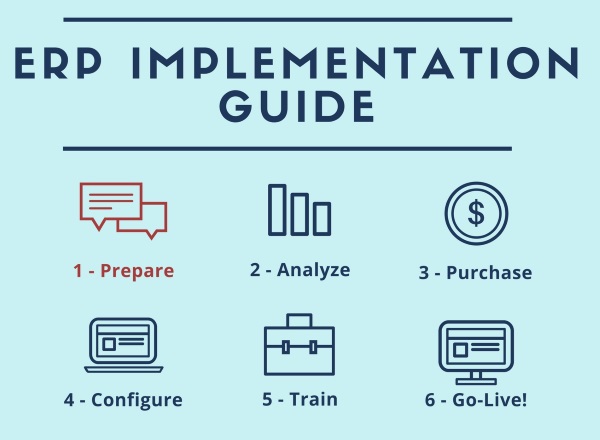Start on the right foot, create a good ERP implementation plan.
Otherwise you seriously reduce your chances of success of your ERP project.

An ERP implementation is not simple. You have to invest time, money, efforts and challenge the company.
Believe me, it’s all worth it! But to have a successful project, start by having a solid ERP implementation plan.
By the end of this step, you’ll have project’s objectives and a budget in hands. The project leader and the super-users will be decided and a communication plan will be built.
Are you sure you are ready?
Review what it means to implement an ERP before starting. Because if you’re not ready to put the effort or to dodge the common mistakes, you’ll just waste your time and money…
An ERP Implementation is a long-term project, start the right way!
Build your ERP Implementation Plan
Step 1 – Identify global objectives
The first step is to decide the global objectives of the ERP implementation.
What do you want to achieve?
Do you want to improve the business performance? Is it to replace an old system? Do you want to make your employees job easier?
Identify the global objectives and what the upper-management wants to accomplish.
This will lay the foundation for the ERP project.
Step 2 – Set the Budget
Discuss the overall budget.
Even if at this point it’s difficult to guess how much the implementation will cost, it’s good to know how much money the company can invest in that project. Is it 100k, 1 million, ten million?
For a small business, the cost of the ERP should be between 50 000$ and 200 000$. A medium business may expect to pay between 1 and 10 million dollars while large enterprises will need to invest more than 10 million.
Step 3 – Identify the leader of the project
Identify a Project Leader. Why?
He’ll be the go-to person and will ultimately responsible for the project. He’s going to make sure the project is on track, that the project team has everything they need and he will report to the upper-management.
This person needs to be available for the project team and should have good knowledge of the company.
The higher this person is in the hierarchy, the better. He’ll make key decisions that will impact the company for years.
Step 4 – Choose the super-users
Choosing the right super-users is an important step of your ERP implementation plan.
They’ll be the main reference for the ERP Project and the end result greatly depends on them.
They will be working with the implementation team to identify the business needs and they’ll also be the reference in their domain of expertise throughout the whole ERP implementation (and even after). Choose the most knowledgeable employees.
Depending on the department size, choose 1 to 3 super-users for each. You may choose managers or end-users, but choose employees that have actual knowledge of the department daily operations. Unless it’s a very small department, choose at least 2 super-users to make sure you have different point of views.
Since they will be very busy during the implementation, choose motivated employees that will commit to the project. People will also come to them for answers after the implementation, so they should be sociable and willing to help other people.
The perfect end-user
The perfect super-user is:
- Very knowledgeable and confident in his field / department
- Have a very good understanding of the department’s business processes
- Able to transfer knowledge and willing to help others
- Motivated
Don’t forget, choosing your super-users carefully is very important. The ERP will mostly reflect their vision of the company.
Also, in the first months of operation, they’ll be the ones you rely on to run the ERP and to answer other employees’ questions.
Step 5 – Build a communication plan
Since everyone in the company will have to participate in the project one way or another, it’s a good idea to build a communication plan to keep the employees informed on the state of the project.
It eliminates uncertainties and makes sure that everyone is on the same page. A newsletter every month or two is a minimum.
Next step: Step 2 – Business analysis
Home > ERP Project > ERP Implementation Plan
